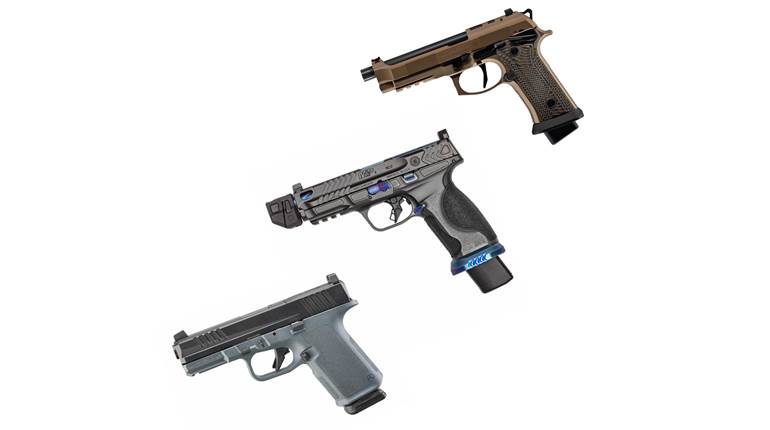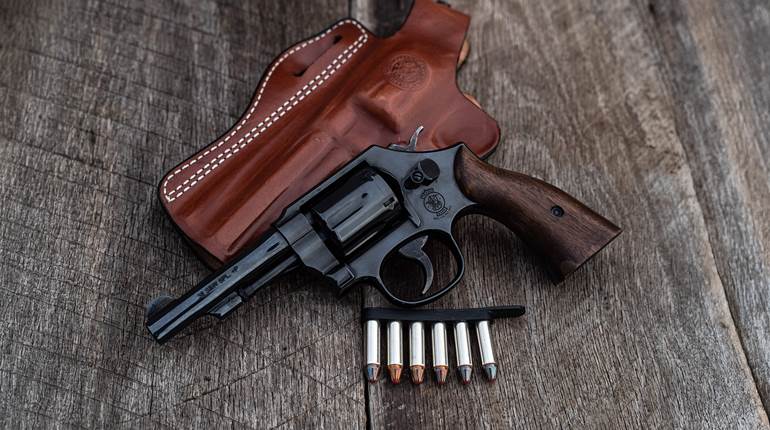
9/18/2012
The history of the Colt New Frontier single-action revolver actually begins in the latter part of the 19th Century, some 120 years ago. In the late 1800s there was a growing interest in target shooting with handguns, not only in the United States, but also in Great Britain and Europe. To meet that need Colt began to offer the Single Action Army with adjustable target sights.
The Colt Flat Top Target, as the then-new sixgun was called, featured a flat topstrap instead of the traditional rounded topstrap with the grooved rear sight. Dovetailed into the topstrap was an adjustable rear sight, somewhat crude by today’s standards, but adjustable nonetheless. The Colt Flat Top Target single-action was manufactured from 1890 to 1898 and, during that time, a little more than 900 revolvers were produced.
Colt dropped the production of single-action revolvers at the beginning of World War II, so it could concentrate on the production of military arms. By about 1956, however, Colt decided that the time was right to resume manufacturing the Single Action Army with the idea that a target-sighted single-action wouldn’t be far behind.
The New Frontier was introduced in 1961, and the name “New Frontier” took advantage of the slogan made popular by President John F. Kennedy. From the outset, the Colt New Frontier was to single-actions what the Colt Python was to double-action revolvers, the Cadillac of handguns. The target-sighted single-action came with a smooth action, attractive finish, high-visibility adjustable sights, and smooth walnut stocks with the Colt logo in silver or gold.
Colt produced the first run of the New Frontier revolvers from 1962 until about 1974. Reintroduced in 1978, it was again dropped from the line in 1982. During those two runs, the New Frontier was chambered for .38 Spl., .357 Mag., .44 Spl., .44-40 Win. and .45 Colt. It was available in barrel configurations of 4 3/4, 5 1/2 and 7 1/2 inches.
Gunwriters such as Elmer Keith and Skeeter Skelton championed the Colt New Frontier and made a convincing argument for the value of adjustable sights on a single-action revolver. My own introduction to the New Frontier came with a photograph in one of Skelton’s articles. The picture showed a 4 3/4-inch, .44 Spl. New Frontier, complete with ivory stocks, lying on a silver serving tray. Skelton, by the way, was almost single-handedly responsible for convincing the various gun companies to keep producing the venerable and dependable .44 Spl. cartridge and the guns that chambered it.
In 2011, Colt once again announced that the New Frontier would be included in its catalog. I had the opportunity to shoot some prototypes at the 2011 SHOT Show and was duly impressed. But I have always preferred to test and write about production models of new guns so that I would be testing the same kind of gun that my readers would be buying. With the Colt New Frontier, that chance came early in 2012, when Colt's Mfg. shipped me a 4 3/4-inch barreled .45 Colt and a .44 Spl. with a 5 1/2-inch barrel. The .44 Spl. had a barrel marking that read, “175th Anniversary” along with the dates “1836” and “2011.”
My first positive impression of both guns was assured by the attractive color-case hardening on the frames. Without a doubt this is the best job that I have ever seen on a Colt revolver. The colors are vivid, deep, and let you know right from the beginning that you are holding a classy handgun. The barrel, cylinder, and grip frame all have a blue finish that is also quite attractive, being so dark it almost looks black.
The next thing that I check on single-actions is the fit of the backstrap and trigger guard to the frame. On Colts the backstrap and trigger guard are two separate pieces. In the past, it has not been uncommon to find guns with “proud” steel, that is, parts that did not mate flush with each other. One or the other edge would protrude, leaving a sharp place to gouge flesh out of the shooting hand. However, such was not the case on either one of my test guns.
The backstrap, trigger guard, and frame fit to each other about as well as anyone could expect. On a recent visit to the Colt factory I learned that a lot of hand fitting is still being done on all of the Colt single-actions. Although Colt uses the latest in computerized machinery, the final stages involve a good deal of hand filing so that the various parts will mate just right.
The front sight is a tall ramp type with horizontal serrations that help to cut glare just a bit. The rear sight is the well-known Elliason adjustable target sight that used to be found only on the Colt Gold Cup M1911. The Elliason has a reputation for being an extremely sturdy sight and yet, at the same time, capable of great accuracy.
Like the latest Single Action Army revolvers, these New Frontier sixguns have the full-length cylinder-pin bushing like the originals. There was a time when someone had decided that a shorter bushing, force fit into the cylinder, would cost less in the long run. Well, it cost less alright, but the cylinder couldn’t be removed in the field for cleaning, or adjustment, and it turned out to be just generally a bad idea. It appears that Colt has listened to its customers and gone back to the easily removable, full-length bushing.
From the very beginning, the Colt New Frontier has sported smooth, oil-finished walnut stocks with Colt medallions installed. The best thing you can say about the stocks is that they are plain. In fact, I’ve seen shipping pallets that had more grain and figure than the New Frontier stocks. And it’s always been that way. I suppose you could say that the stocks are a way that Colt has of reminding us that its New Frontier revolvers really deserve custom stocks of ivory, pearl, stag or fancy woods. In truth, every New Frontier that I’ve ever owned didn’t wear those walnut stocks very long at all. Still, as good looking at the Colt New Frontier revolver is, performance is what really matters.
This is a good place to discuss an important safety feature on all traditional single-action revolvers. And that is the fact that they should only be loaded with five cartridges, with the hammer being down on the empty chamber. If all six chambers were loaded and the hammer all the way down, the firing pin would be resting on the primer of a live cartridge. In addition, the single-action revolver is balanced in such a way that, when dropped, it will land on its hammer eight times out of 10. When this occurs, you can expect the gun to fire. Having grown up in the Southwest, I know of a number of people who have been injured, and in some cases killed, by ignoring this important safety issue.
One might point out that, as the hammer is cocked, the first click indicates what some people call the “safety notch” and that this should allow one to carry six cartridges. They could not be more wrong! This so-called “safety notch” is a thin, fragile shelf on the base of the hammer. It could be sheared, or broken, very easily when the gun is dropped.
You might want to keep in mind that the design of the traditional single-action revolver has been around for a very long time. And a whole host of gunfighters, cowboys and lawmen were tinkering with this same design long before you and I were born. They all came to the same conclusion that it was best to carry five rounds in the single-action and let the hammer ride down on an empty chamber. It would be a really good idea if you did that, too.
The most efficient way to accomplish that is what the old timers called “five beans in the wheel.” Using this technique, you can load the single action without looking at it and you can even load it in the dark. “Five beans in the wheel” consists of five easy steps: 1. Bring the hammer to half cock; 2. Open the loading gate and load one chamber; 3. Skip the next chamber; 4. Load four more chambers; and 5. Bring the hammer to full cock and ease it down on the empty chamber.
In order to put both the .44 Spl. and .45 Colt New Frontier revolvers through their paces, I gathered five different factory loads in each caliber and headed to the shooting range. I tested each gun by firing five-shot groups at 25 yards, using a rest on the shooting bench. Velocities were averaged from five consecutive, five-shot strings, with the PACT chronograph set 15 feet in front of the muzzle. Temperature on the day of my tests was 89 degrees F, and there was no noticeable wind.
All of the .44 Spl. ammunition performed well; however, the nod went to Winchester’s 200-grain Silvertip which ran at 848 fps and gave 1 1/4-inch groups. Nonetheless, my favorite .44 Spl. loads are built around 240- or 250-grain Keith semi-wadcutter bullets running 900 to 950 fps. There is just not much, handgun-wise, that you can’t do with this kind of .44 Spl. load. In my tests, the DoubleTap 240-grain KSWC factory load chronographed at 904 fps and gave 1 1/2-inch groups.
Likewise, the 4 3/4-inch New Frontier, in .45 Colt, shot some very nice groups, too. The tightest group (1 1/4 inches) went to the Black Hills cowboy load consisting of a 250-grain round-nosed, flat-point bullet loping along at 722 fps. The most interesting .45 Colt load, though, was the 225-grain cast wadcutter, defense load from Buffalo Bore. It also gave the highest velocity of 1,056 fps.
Both of these New Frontier single-actions performed flawlessly during my tests. I experienced no malfunctions, failures to fire or other mishaps. The sights were easy to adjust and gave a superior sight picture that was a distinct aid in accurate shooting. The actions were smooth and properly timed, with the triggers breaking cleanly at 3 1/2 pounds. Frankly, both guns were good to go right out of the box although, if one of them was mine, it would quickly get a set of ivory stocks. And that is about all I would do and all the gun would need.
Nowadays, we spend a lot of our time contemplating personal defense guns and issues, and for good reason. Still we should never forget that most of us spend our trigger time at the range because shooting is fun. And the Colt New Frontier is a perfect companion for fun shooting. It’s the kind of handgun you want on your hip when you spend the whole day down on the creek, or hiking in the national forest. The Colt New Frontier is a classic example of American firearm manufacturing at its best, and I can’t imagine a sixgun that better exemplifies our nation’s rich shooting traditions.
Manufacturer: Colt’s Mfg. Co. LLC; (800) 962-2658; www.coltsmfg.com
Action: single-action, center-fire revolver
Caliber: .44 Spl. (tested), .45 Colt (tested)
Barrel lengths: 43⁄4" (tested), 51⁄2" (tested), 7½"
Overall Length: 10¼" (43⁄4" bbl.), 11" (51⁄2" bbl), 13" (71⁄2" bbl.)
Height: 5.2"
Width: 1.7"
Rifling: six-groove: 1:16" LH twist (.45 Colt); 1:12" LH twist (.44 Spl.)
Sights: ramp front, Elliason windage and elevation adjustable rear
Finish: blue with color- case hardened frame
Stocks: smooth walnut with Colt medallions
Suggested Retail Price: $1,455




































